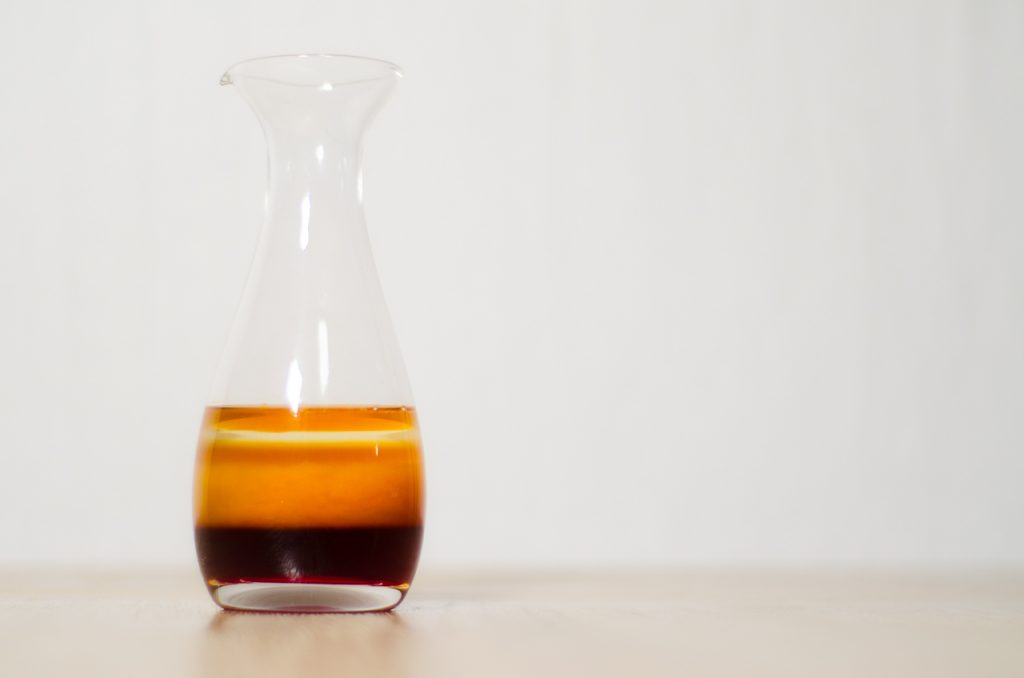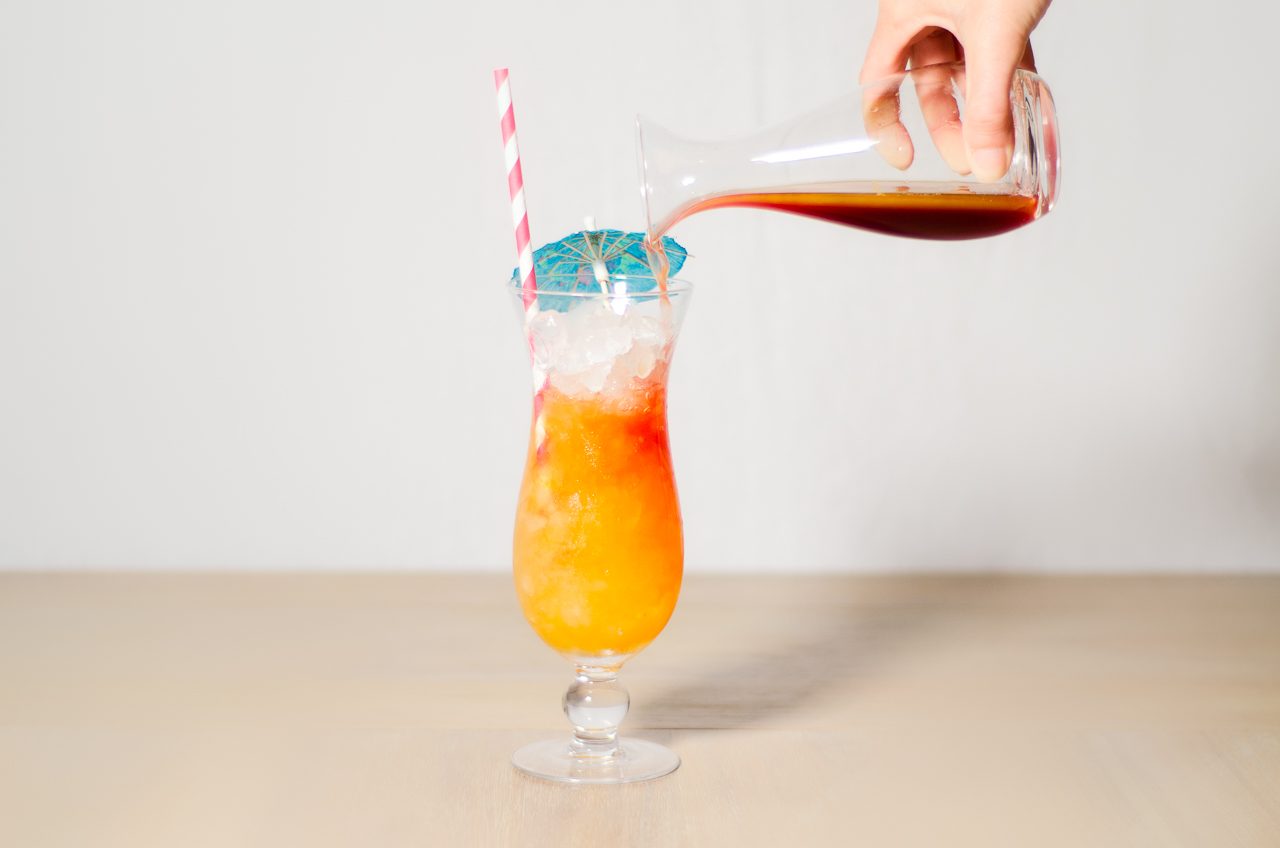Haven’t mentioned it yet, but I am presently obsessed with tiki cocktails and, to a lesser degree, tiki culture. I was very excited when it came time to make this cocktail, since it fits squarely within this obsession. “But wait! Is a Hurricane really a tiki drink? Isn’t it from New Orleans?” you ask. Yes, and yes. The Hurricane was allegedly created by Pat O’Brien in the 1940s in New Orleans in an effort to get rid of excess rum he had on hand. While the cocktail didn’t originate from any exotic locale (like Polynesia, Hawaii or the Caribbean), neither did most tiki drinks. Rather, most exotic cocktails (that’s what they were called in their heyday between 1933 and 1970) were created in pretty un-exotic places like Los Angeles or Oakland at restaurants like Donn The Beachcomber or Trader Vic’s. The fundamental notion of these places was to create an escape from reality. A trip to a tiki bar was like a vacation without the travel.
Most exotic cocktails (what we now call tiki drinks) are comprised of four primary elements: sour, sweet, strong, weak. There’s even a little rhyme that describes the essential ratio: one of sour, two of sweet, thee of strong, four of week. Turns out this ratio isn’t necessarily perfect, but it’s a good starting point.The Hurricane, which is classically comprised of rum (the strong), lemon (the sour), passionfruit syrup (the sweet, plus some additional sour), and ice (the week), would have fit in perfectly at any tiki bar.
So, as I was saying, I was very excited to make this cocktail, and then I tried to buy cranberries. Cue the dramatic music…
It’s April. No cranberries in April. Not even frozen! Damn. Why’d they have to make this with cranberries?? Ugghh!
I am devoted to replicating these recipes as closely as possible to the original, and how could I possibly do this if I can’t find cranberries? Got me to thinking. How is cranberry juice made? I’m not talking about cranberry juice cocktail. But plain old cranberry juice. I did some research and discovered if one were to set out to make their own cranberry juice they would follow the same steps this recipe calls for you to follow to make the cranberry stock. So, maybe it would be possible to use store-bought cranberry juice (made with only cranberries and water) and replicate the cranberry stock called for. That was my theory.
Science drama ensues…
The fundamental problem I faced was this: how does a 32 ounce bottle of organic cranberry (only) juice compare to the cranberry and water mixture described in the recipe? Is the bottled juice more or less tart? Is it made from more or fewer cranberries? How much sugar do I need to add to the juice to match the cranberry stock used in the recipe? In order to figure this out I started cross-referencing nutritional values like sodium, potassium, calcium, and magnesium. For example, the recipe calls for 250 grams of cranberries. How much sodium is in 250 grams of cranberries? How much sodium is in the bottle of juice? By comparing the two I expected to be able to derive the weight of cranberries that went into the bottle of juice. It seemed to work until I started comparing other elements. My results of comparing the various nutrients produced wild variances. I ultimately decided this method couldn’t be trusted. This caused me to abandon the attempt to determine whether or not the juice was the properly tart. I’d just have to accept it the way it was. So I turned my attention to the sugar.
Since I couldn’t reasonably and confidently estimate the amount of cranberry in the juice, I was basically left to guess how to properly sweeten the juice. I did a little extra math but came up with such large amounts of sugar that it seemed unfeasible. Then I was struck by a simple and elegant question: If I were making a tiki drink with 2.25 ounces of rum (as this recipe calls for), how much sugar would I use? Answer: I would use .5 to .75 ounces of rich simple syrup, which is a 2:1 ratio of sugar to water. Conveniently, the dry measurement of sugar that goes into this syrup matches the wet measurement of syrup it creates. So, .5 ounce of rich simple syrup contains .5 ounce of sugar. This recipe calls for 1.75 ounces of cranberry stock, which is the only source of “sweet” in the drink, other than 1 ounce of navel orange juice. I decided to err on the side of less sweet (.5 ounce) to compensate for the marginal sweetness added by the orange juice. So, the resulting assumption is that of the 1.75 ounces of cranberry stock, .5 ounce should be syrup, or a ratio of .5:1.25 or 1:2.5. So, accordingly, to 16 ounces of cranberry juice (I used only half the bottle) I added 6.4 ounces of sugar. The result was a sweet and tart juice, as you would expect. Good news (spoiler alert) – I think it worked out perfectly! The final cocktail was absolutely delicious and perfectly balanced.
Completing the Prep
The rest of the prep was easy and straightforward. Juice a few oranges and limes – I always make sure to juice citrus into a fine mesh strainer, which keeps pulp out and makes the juice clearer.
Passionfruit stock is derived from thawed passionfruit pulp, which is available in the frozen section of the grocery store. The brand I use is Goya, and I find it near other Latin items. It’s a tiki staple, and I keep some on hand at all times! I usually thaw out a package and then freeze it into 2-inch ice cubes. When I’m making a cocktail that calls for passionfruit puree, I just thaw out an ice cube by placing the cube in a zip top bag and letting that bag float in some water in the sink. In just minutes I have passionfruit puree.
The Rum
The business end of this cocktail is a combination of three excellent rums. I encourage you to add each of these rums to your collection, and I would not recommend spirit substitution in this case. These three rums worked perfectly together, and it would be a shame to mess it up with a bad swap. If you happen to be a rum expert, then go ahead and tinker. By all means, please do not make the mistake of assuming rum is rum and substituting that ol’ Bacardi Superior and Captain Morgan you have. The simple truth is that not all rums are created equal.
Smith & Cross Rum is a high proof (114) single pot still rum from Jamaica. Single pot still rums are characterized by certain funk. It’s a rich, thick, flavorful, fuzzy rum that adds depth and backbone to any drink it’s in. It’s my go-to single pot still rum, and you should have a bottle of this on hand.
Banks 5 Island Rum is a lightly-aged blend of rums from 5 different islands. It is a mild, balanced, subtle tipple that works well in many tiki drinks. It would be very easy to confuse this as interchangeable with other clear (white) rums, like Bacardi Superior, for instance. And if you are tempted to commit that sin, which I have been in the past, I invite you to pour a little taste of each and compare them back to back. One tastes like something you would use to strip furniture, and the other tastes like a vacation. You decide which is which, and then use that one in this and all future drinks. Maybe you can then move the other bottle to the garage, where it belongs with the other harsh chemicals in your house. Side note: Banks also makes a 7 Island Rum, which is equally delicious. It’s worth owning both.
Dos Maderas 5 + 3 is another moderately-aged rum. This is a blend from two islands – Guayana and Barbados. The rum is aged for 5 years in its country of origin. Then, after blending, the rum rests for 3 more years in sherry casks, in Spain. This rum has a unique flavor, presumably from the sherry casks, and blends well with other rums in tiki drinks. I have not found a suitable substitute for this rum, and so I recommend you have this on hand as well.
Finishing the Cocktail

Bringing this all together is a less than simple matter of layering the various rums and juices and stocks. Frankly, I feel the picture in the book is staged for aesthetics, and not actually a picture of this exact recipe. I don’t blame them…there’s looks much prettier than mine. After carefully layering multiple attempts, I’m pretty convinced that you can’t make it look like the picture!
Layering requires a cocktail layering device. The one I use directs the liquid you pour into it into a flat stream along the side of the glass. It works decently, though, as I mentioned, I was unable to create 7 distinct layers.
But the presentation, in a small carafe, is very nice. Pouring it from the carafe over crushed ice in a hurricane glass is fun and creates a great look. More importantly, the taste of the final concoction is wonderful. I use these carafes and this ice crusher.
If you love this cocktail, as I do, and would like to enjoy it with less hassle, keep some of the cranberry stock on hand, keep passionfruit puree ice cubes in the freeze, skip the layering, and shake these up after juicing oranges and limes. You could throw these together in minutes. You’ll thank me when you do!

